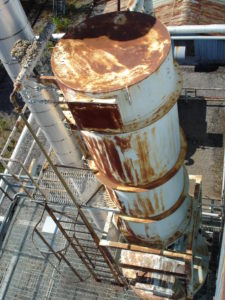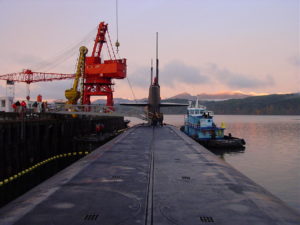
obsolete power plant
If you want to know why something is said or done, ’follow the dollar’ – in other words, find out who stands to benefit. Earlier this week an article in the Brisbane Times argued that future generations would ‘rue the day’ that the Government failed to take advantage of current low interest rates to invest more in infrastructure. The arguments were being put forward by a multinational company that constructs infrastructure! It is clearly in their interests, but is it in ours? The writer of the report wrote “Borrowing money to build the infrastructure for a future economy is not only the right thing to do, it is absolutely essential to our future economic prosperity.” But is it?
With low interest rates why isn’t the private sector investing if it is such a good idea? May be they cannot see the demand necessary to justify the extra capacity they would be creating? Also they are aware that the economy is in a state of flux and are probably, and sensibly, seeking more clarity on the future before they consider committing shareholder funds. Do we really want our governments to be any the less wise with our funds?
Economists, looking only at the cost of borrowing, often argue that we should borrow to spend at times when interest rates are low. In a recent ABC news item, Glenn Withers, economist at the ANU, argued that current low interest rates meant this was a good time to invest in infrastructure but Gary Bowditch, Head of the Better Infrastructure Initiative at Sydney University said the price of money and historically low interest rates were “completely meaningless in the current context, first we needed to be choosing the right projects”.
Question: Who do you agree with, and why?
 I have been told that, today, asset managers and other middle to senior management decision-makers, are becoming a victim of the drive for ‘efficiency’: resources are being reduced, workloads increased. So much so, that they have ‘no time to think’. If this is true there are some very serious consequences.
I have been told that, today, asset managers and other middle to senior management decision-makers, are becoming a victim of the drive for ‘efficiency’: resources are being reduced, workloads increased. So much so, that they have ‘no time to think’. If this is true there are some very serious consequences.
I recall a client of mine who wanted my help in developing strategic policy and planning for her more than two billion dollars of education assets: schools and colleges. Her day was back-to-back meetings, so much so that we had to get together for policy discussions over coffee at 7 am or else after her day eased off at 7 pm. I asked her, with such a hectic schedule, when did she ever get time to think. She smiled wryly, shrugged and said “When I get home!” I was concerned for this bright young woman but also for her staff who really needed the strategic direction that she should have had the time to give them. Then my concern moved to the students, who were being shortchanged by not having infrastructure decisions thoughtfully coping with changing needs, and to their parents and their future employers. The whole community misses out when infrastructure decision-makers do not have time to think.
And the individual misses out too. With increasing automation, jobs that do not require thinking are going to be taken over by robots. Do we really want infrastructure decisions made by computer algorithms, by robots?
Questions today
Is it true that many decision-makers believe they have ‘no time to think’?
Is this something we need to address, and if so, how could we do it?
 As a young economics student I was all for efficiency. So much so that if it could be proved that it was ‘efficient’ to send women and children down the mines – down they would have gone! But is economic efficiency to be our only criterion for evaluating government and infrastructure policy?
As a young economics student I was all for efficiency. So much so that if it could be proved that it was ‘efficient’ to send women and children down the mines – down they would have gone! But is economic efficiency to be our only criterion for evaluating government and infrastructure policy?
I thought of this when reading Leith van Oselin’s comment on the Federal Government’s submarine project. Writing in Macrobusiness as the ‘Unconventional Economist’, he nevertheless puts forward a very conventional economic argument. Using the release of the Productivity Councils’ 2014-15 Trade and Assistance Review as his starting off point, he argues: “Paying more for local builds, without sufficient strategic defence and spillover benefits to offset the additional cost, diverts productive resources (labour, capital and land) away from relatively more efficient (less assisted) uses. It can also create a permanent expectation of more such high cost work”. The article is titled “PC hits out at submarine pork”.
Our question today: Seems straightforward enough, doesn’t it? But is it?
 Strategic Asset Management doesn’t have to be difficult. It can be as simple as 1-2-3.
Strategic Asset Management doesn’t have to be difficult. It can be as simple as 1-2-3.
- One principle
- Two types of question
- Three asset measures
The One Principle: All strategic questions are portfolio questions
In other words if the question you are asking relates to a particular asset or just one part of a portfolio it is an operational or a tactical question to be dealt with by managers at that level. Strategic questions, that is portfolio level questions, need to be addressed ‘at the top’.
The Two Types of Strategic Questions – Direction Questions and Decision Questions
Direction Questions are those that help the agency see its current position and the direction it is moving in, and the direction it wishes to move in
Decision Questions are those that evaluate a particular capital proposal (new, renewal, modification or disposal) – but always in the light of the total portfolio.
The Three Asset Measures
1. Capacity – answering the question “how much?”
2. Condition – answering the question “what state is it in?”
3. Suitability – answering the question “how fit for purpose?” or “how effective?”
All three measures need to consider the context of the question, for example, when answering the ‘how much’ question we are simultaneously looking at ‘how much do we need’ and ‘how much have we got’. Knowing one without the other gives no basis for action. Similarly ‘what state is it in’ must be answered in the light of ‘what state do we need it to be in’. And ‘how fit for purpose?’ means understanding the requirements of the desired purpose.
For today’s Infrastructure Decision Making, a key question is:
How long do we WANT it to last?
All contexts have an implied time line. We used to believe that this time line was, effectively infinite, or at the least, very long. We would aim for ‘sustainability’ interpreted as keeping the asset operational for as long as possible.
Today, our strategic decision-making requires realising that this effectively infinite time line no longer applies.
Much more effort is now required to determine not only how long could it last, but how long – in the light of changing demand and supply – do we need it to last. This could well be the most significant strategic asset management decision that we now make.
Feel free to post your comments and questions

Recent Comments